Old and New Technologies Set to Flourish
Advances in optics in the past year or two have ranged from promising new optical materials to innovations in existing technologies. From optical coatings and add-on kits to quantum dots and metadevices, the scope of progress is as extensive as it is varied.
In consumer electronics, for example, the trend for high-definition viewing and new displays is pushing precision optics to the fore. Even trends in consumer viewing habits are having an impact: For example, the growth of online and on-demand video (e.g., Netflix) has effectively made DVD mastering obsolete.
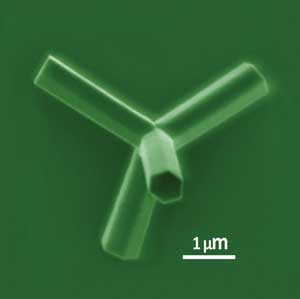
The tetrapod (four arm) quantum dot from Quantum Materials represents QD advances that the company says will enable crisper high-definition displays and other applications. Courtesy of Quantum Materials.
One fascinating trend, for which we have seen only the tip of the iceberg, uses optical add-on kits to convert everyday consumer electronics into scientific devices; e.g., today you can find kits to turn your iPhone into a microscope or your iPad into a spectrometer.
These innovative mergers will continue, according to optics, imaging and photonics specialist Edmund Optics Inc. of New Jersey.
“Who knows what merger tomorrow will bring,” said Edmund Optics’ senior product line manager, Gregg Fales. “But, ultimately, bringing these optical devices to the masses can only enhance R&D and scientific discovery, and provide us with a better world in which to live.”
In the defense sector, Edmund Optics notes a trend to commercialize the IR spectrum as a whole. “The price-per-pixel on infrared sensors continues to decrease, and as defense budgets continue to be trimmed, more and more companies are looking to apply their technology in the commercial space,” Fales said. “Naturally, applications such as security and sensing translate well into the commercial area, but I believe other markets will find applications as well.
“Continued development of chalcogenide materials and development of more achrothermal – designs that are achromatic and passively athermal – material choices will enable this transition.”
In the clinic, increasing use of point-of-care equipment demands compact, flexible optics that can transform laboratory diagnostic equipment – traditionally centralized in hospitals – into personal-use instruments.
“The transition toward point-of-care equipment demands lower cost and smaller footprints,” said Michael Tenalio, director of product management in the Optical Systems Group at Melles Griot in Rochester, N.Y. “To meet these demands of lower cost, smaller footprints and miniaturized electro-optomechanical solutions, we continue to innovate our multielement optical lens solutions.”
Even though the art of manufacturing lenses hasn’t changed much in the past few hundred years, metrology has come a long way, enabling lens makers to produce better lenses using traditional techniques. Advances in metrology, including deterministic polishing, mean that customers can correct or, in some instances, intentionally introduce known quantities of optical aberrations in their systems, and the equipment to produce and measure lenses capable of achieving the results is improving.
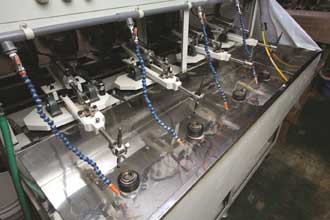
Optical polishing is a blend of experience and technique that produces highly consistent results. Photo courtesy of Edmund Optics.
“And perhaps most importantly, there are now lots of options for customers to achieve the results, in [a] variety of cost-to-performance ratios,” Fales said. “Free-form surfaces can be diamond-turned, small diameters can be molded, precision surfaces can be ground and polished, and mild departures can [be] ‘aspherized’ out of a cured polymer.”
Melles Griot also predicts that the emergence of reflective optics, reflaxicons, or reflective axicons, will rival that of aspheres and create game-changing options in shapes, designs, price points and sizes for optics and photonics applications.
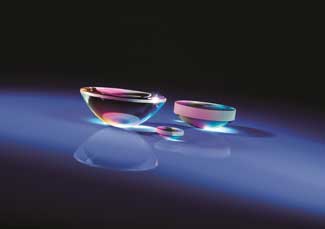
Precision aspheres in the Techspec family from Edmund Optics correct for spherical aberration. Photo courtesy of Edmund Optics.
“Continued improvements in thin-film lens coatings and reflective optics provide for multivariate lens applications,” Tenalio said. “Coatings can add new properties to the base lens material, and provide for impact and scratch resistance, or can be added to meet ultraviolet-light blocking, reflectance or conductivity requirements. Reflective optics will be an innovative game changer for many years to come by enabling high-precision optical designs.”
So, while the vast majority of lenses used in the commercial space are produced in the same way today as they would have been made a century ago, there are many developments in deterministic and additive manufacturing that continue to keep pace with market demands.
Lighting: Rebirth of the incandescent?
We all are familiar with the merits of energy-efficient, environmentally friendly LED lighting, seen to be leading the lighting revolution and making traditional technologies obsolete. But there is a growing voice that demands that we reconsider the humble incandescent lightbulb.
Energy efficiency has driven much legislation and investment in recent years, which has seen most of the major lighting manufacturers invest almost exclusively in LED lighting systems. For example, lighting heavyweights such as Cree Lighting, LG and Samsung offer only LED-based lighting products.
However, at Deposition Sciences Inc. (DSI) of Santa Rosa, Calif., the belief is that the incandescent lightbulb is far from dead, and that we could all benefit from more lighting producers shifting more focus onto energy-efficient halogen lighting products.
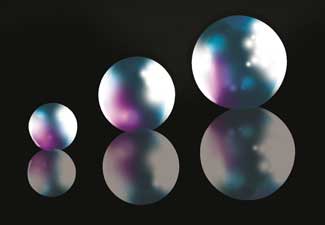
Edmund Optics’ Techspec optics can focus and couple light quickly and effectively. Photo courtesy of Edmund Optics.
“Trends in government appear to be moving away from aggressive energy-efficient lighting legislation and implementation,” said Lee Bartolomei, president and CEO of DSI. “Energy-efficient lighting technology has been demonstrated, but the introduction of products that incorporate this technology will be severely limited without government involvement through legislation and investment.”
DSI has seen rapid improvements in the efficiency of hybrid halogen incandescent lightbulbs over the years, thanks to work being done to increase the amount of heat recycled to the filament. This increase in the amount of recycled heat comes from boosting the IR reflection from the thin-film coating applied to the halogen capsule.
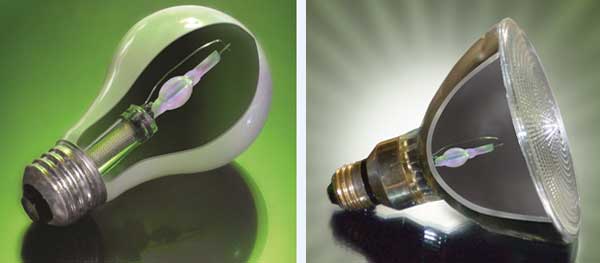
Hybrid incandescent lightbulbs. DSI has seen rapid improvements in the efficiency of hybrid halogen incandescent lightbulbs over the years. Photo courtesy of DSI Inc.
“New coating materials have increased the efficiency and reduced the cost of IR coatings on halogen lamp burners,” said Dr. Bob Gray, senior scientist at DSI. “The invention by DSI of the coated-shroud approach to halogen energy efficiency lighting has further improved the potential for improved efficiency and lower cost.”
The shroud eliminates the need to apply the coating directly to the lamp burner and, by doing so, reduces the temperature to which the coating is exposed and enables more efficient and less costly coating materials and designs to be used.
DSI’s president expects big things from the somewhat-forgotten technology: The rate of improvement in lumens per watt and the reduction in the cost of the optical coating of the hybrid halogen incandescent bulb has proceeded in a recurring pattern, Bartolomei said. He has dubbed this pattern “Bartolomei’s law.”
Similar to the famous Moore’s law for electronics, Bartolomei’s law states: “Every four years, the micron-per-square-centimeter deposition rate for IR coatings on halogen lamp burners doubles, while the coated burner performance (lumens per watt) increases by 20 percent.”
Using Bartolomei’s law, the company predicts that by 2018 the efficiency of a hybrid halogen incandescent lightbulb will exceed that of the current CFLs (compact fluorescent lamps) and equal LEDs on the market by 2023.
Today, limited quantities of halogen lamps with 1.5 and two times the lumens-per-watt efficiencies of standard incandescent lamps are on the market, and lamps with three times the efficiency of standard incandescent (45 lm/W) have been demonstrated by DSI in the laboratory.
From metamaterials, metadevices
Useful, functional devices are starting to emerge from the realms of metamaterials research. The research agenda is to achieve tunable, switchable, nonlinear and sensing functionalities by structuring functional matter on the subwavelength scale.
Metamaterials are defined as artificial electromagnetic media that exhibit unexpected optical properties as a result of their subwavelength-scale structure. One of the first technologies to emerge was the negative-index “superlens” – a remarkable result, in which light is refracted in the opposite direction from that of conventional materials.
Other early outcomes include chiral materials, which rotate the polarization state of light hundreds of thousands of times more strongly than natural optical crystals, and structured thin films with remarkably strong dispersion that can slow light in much the same way as resonant atomic systems with electromagnetically induced transparency.
Today, the shift sees metamaterials transformed into “metadevices.”1 Robust and reliable metadevices will allow photonics to compete with electronics not only in telecommunications systems, but also at the level of the photonics found within consumer products such as mobile phones or automobiles, argues professor Nikolay Zheludev, director of the University of Southampton’s Centre for Photonic Metamaterials in England and of the Centre for Disruptive Photonic Technologies at Nanyang Technological University in Singapore.
The main challenges in achieving this vision will be in developing cost-efficient fabrication and device-integration technologies. “Substantial new developments include reconfigurable photonic metamaterials that offer optical properties ‘on demand,’ ” Zheludev said. He and colleagues have already presented an electromechanically reconfigurable plasmonic metamaterial operating in the near-IR.2
Tuning, switching and modulating metamaterial properties in the visible and near-IR range are major technological challenges. The solutions used today for subterahertz and terahertz regimes cannot be shrunk by two or three orders of magnitude to enter the optical range.
But Zheludev’s group has developed a type of metamaterial that seems to conquer this barrier by harnessing the electrostatic forces that become dominant at tiny distances.
They use potential differences of just a few volts to overcome the elastic response of suitable nanostructures. The result is an electrically reconfigurable metamaterial operating in the optical part of the spectrum at a modulation speed three orders of magnitude faster than its terahertz equivalent.
The metamaterial can be operated at microwatt-power levels and can provide continuous modulation of optical signals with megahertz bandwidth. Such devices are compatible with optoelectronic systems; for example, as tunable spectral filters, switches, modulators and adaptable transformation optics devices.
Looking ahead, the low-energy, high-contrast, nonvolatile switching mode of these devices may also have applications in protective optical circuitry and reconfigurable optical networks.
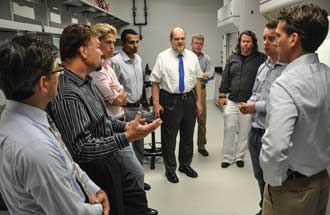
Quantum Materials’ research, management and finance team discusses developments at the company laboratories at Star Park in San Marcos, Texas. Photo courtesy of Rich Schineller.
“Metamaterial[s] are 12 year[s] old. Give metamaterials another 20 year[s] and they will change all optical technologies as we know them,” Zheludev said.
The field is certainly growing: The first SPIE conference on Metamaterials, Metadevices and Metasystems will be held Aug. 17-21.
Quantum dots, tailored solutions
This past year saw the introduction of the quantum dot (QD)-based display in the form of the Sony Triluminous HDTV. Thanks to their near-unity emission quantum yields and narrow emission bands, QDs exhibit excellent color purity, making QD LEDs, TV displays and lasers extremely promising avenues of research.
QDs are nanosized semiconductor particles whose emission color can be tuned by simply changing their dimensions. “For electronics, this means that color enhancement designs will provide higher definition through distinctions among colors as well as higher contrast through ‘darker’ blacks,” said David Doderer, vice president of R&D at Quantum Materials Corp. in San Marcos, Texas. The company specializes in the mass production of colloidal tetrapod QDs for the electronics industry. “Ultimately, the use of quantum dots in displays will allow higher pixel rates per area towards even more crisp high-definition TVs.”
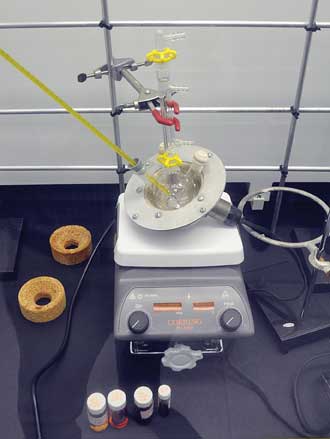
The tetrapod-QD sample batch apparatus at Quantum Materials’ laboratories in San Marcos, Texas. Photo courtesy of Rich Schineller.
While quantum dots have been broadly used in biological applications to provide useful cellular data to researchers for some time now, their use in electronic signals is coming into line with price points that up until recently have been too high.
But it is the inherent tunable nature of QDs that is starting to grab the attention of more and more scientists and becoming better understood via advanced testing methods. In fact, common engineering hurdles for specific applications are more readily solved with well-designed quantum dots.
“Within five years, we predict widespread use of quantum dots in major markets to include televisions, displays, biological marking, discrete or less-than-visible marking for product security and low-cost solar cells,” Doderer said. “Overall, we would expect that the quantum dots will enable engineered products that simply weren’t possible with ‘top-down’ design that is limited by manufacturing methods or bulk material properties.”
References
1. N.I. Zheludev and Y.S. Kivshar (2012). From metamaterials to metadevices. Nat Mat, Vol. 11, p. 917, doi: 10.1038/nmat3431.
2. J.Y. Ou et al (2013). An electromechanically reconfigurable plasmonic metamaterial operating in the near-infrared. Nat Nanotech, Vol. 8, pp. 252-255, doi: 10.1038/NNANO.2013.25.